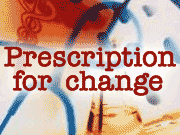 |
| Tom Mueller is manager of human resources at Jagemann Stamping Company. The company encourages its employees to develop healthy habits. There's a basketball hoop right on the factory floor, and workers often play pick-up games after a shift. (MPR Photo/Stephanie Hemphill) |
Duluth, Minn. — Consumer-driven health care asks us to approach health care the same way we approach buying a car. We're supposed to do some research, compare products and prices, and then make our choice, based at least partly on economics.
Healthy people shopping for health care have a lot more choices than people who who are sick.
Millions of people live with chronic ailments -- everything from back pain to mental illness. They tend to use health care services more often, and more intensively.
About 20 million Americans have asthma. Twenty-one million have diabetes, and 22 million have heart disease.
Those illnesses are expensive. Experts say just 20 percent of Americans, including those with chronic ailments, are responsible for 80 percent of the cost of health care. So any attempt to reduce the overall costs of health care has got to take them into account.
In the last few years Anne Skenzich has joined that group. She's a fraud investigator for UnitedHealth Group, a national insurance and health information company based in Minnesota.
Skenzich injured her back in a car accident a few years ago. She's had more than a dozen procedures to limit her pain.
"The last one reduced the pain as far as it could at that point," she says. "Medical technology hasn't gone beyond that at this point to where I can do anything else."
She takes a nerve block and a muscle relaxant every day. She also takes prescription medicine for high blood pressure, allergies, and asthma.
Her employer has been moving gradually to a consumer-driven health plan. Each year the company pays for the first $400 of a $1,000 deductible. Skenzich and her co-workers have to pay for everything from doctor visits to tests to trips to urgent care, until they've spent $1,000. The plan also has an out-of-pocket maximum of $2,000; that's the most they should have to spend on health care expenses each year.
Skenzich says the problem is: what she pays for prescriptions doesn't count as part of the deductible or the out-of-pocket maximum. She says she was told the policy allows her to count only expenses related to "medical treatment."
"And they don't consider medication as part of your medical treatment. That was how it was explained to me by the customer service reps," she says.
The plan does pay about half the cost of most of her drugs. But each month her prescription co-pays amount to about $150 from her own pocket, and co-pays for drugs don't count toward her deductible or out-of-pocket maximum. Even though her drugs don't count, Ann Skenzich pays for enough doctor visits and other expenses to reach her deductible each year.
To pay those and other medical bills, she cashed in three retirement accounts. She saves money wherever she can, she says she hardly ever buys any clothes, and she keeps her house so cool she wears a hooded sweatshirt to bed.
"There's no winning in this. You can't not get health care, and I don't know what's going to happen when I run out of money. I don't know," she says.
The new movement designed to reduce health care costs is costing Anne Skenzich thousands of dollars more each year.
According to UnitedHealth Group, her expenses could be even higher if her plan counted prescriptions toward the deductible. Spokesman Daryl Richard says co-pays are designed to save consumers money, because they keep a lid on the deductible.
FROM PATIENTS TO CONSUMERS
Consumer-driven health care plans can work for people with high medical bills.
Mike Grahek knows that from personal and professional experience. His job involves helping schools and local governments choose health plans for their employees.
A couple of years ago he attended a training session on consumer-directed health care. His co-workers wanted to know what he thought of it.
"And I said I didn't like it," Grahek says. "Because as a consumer, even though I went to some specialized training, I just focused on high-deductible health care plan."
The high deductible worried him because he had triple bypass surgery three years ago, and he takes six medicines a day. He knew that in a high-deductible plan he'd have to pay a lot of those increased costs out of his own pocket. But now he's converted. He likes the new plan because of his high medical bills.
Here's how it works: Each year Grahek has to pay the first $1,800 for his medical care. But once that obligation is out of the way, insurance pays for everything.
"I'm an example where I've blown through the deductible, but my out-of-pocket costs still have been less than if I'd stayed under the traditional plan," according to Grahek.
That's because in the traditional plan the cost of monthly premiums went up 10 to 20 percent every year. And the new plan keeps premiums down.
With the high-deductible plan, workers have an incentive to be careful about what they spend on their health. Mike Grahek says in a way, it changes them from patients into consumers.
"When they're sick, maybe they're making a choice whether they should go buy something over-the-counter, or call the nurse care line or maybe call into the emergency room before they go. So they're making more economically wise decisions, because now they're finally involved in economics of their health care decisions," he says.
So Grahek says that means people are likely to use fewer health-care services. Their costs go down, and that translates into lower costs for their employer, which results in lower monthly premiums.
Grahek's employer saved a lot of money on lower premiums, and it used that money to subsidize the high deductible. The employer pays for three-fourths of the yearly deductible for Grahek and all his co-workers. And employee contributions are made tax-free.
Consumer-driven health care is emerging in different forms around the country. Employers are trying all sorts of ways to save money.
John Miall, a health care consultant who's spent the last decade developing a cost-effective way to help people with chronic conditions stay healthier, questions the motives of companies choosing what he calls consumer-directed health plans.
"The understanding I have of consumer-directed health plans is that they are largely driven by the financial interests of employers to shed themselves of the financial burden of continuing to provide health care," according to Miall.
Miall says if businesses can't figure out how to keep health care costs down, why should we expect employees do any better? And he says too many people will deny themselves the care they need in order to save money, so when they finally go to the doctor, they may need much more expensive care -- or they may never get better.
"When people don't access care until after they're sick, it's often too late for physicians to work any magic," Miall says.
INVESTING IN HEALTH
But Miall says there is a way to get people to use health care conservatively and still stay healthy.
He calls it "patient self management."
It started as an experiment in Asheville, North Carolina, when Miall was the risk manager for the city. And now it's been expanded to several other cities. Essentially, employers and employees make an investment in worker health. And they can both end up saving money.
The Medicine Shoppe in Two Rivers, Wisc., is running a patient self-management program. John Parkos squeezes himself into a space curtained off from the busy pharmacy. Parkos has diabetes. He's here for his monthly visit with pharmacist Brenda Strawn. She's got a chart that tracks his progress.
The company Parkos works for pays for all his diabetes-related visits to the pharmacist and to the doctor; it pays for his testing equipment and his medications. That saves Parkos $100 a month.
For his part, he's agreed to meet regularly with a pharmacist and work on personal goals for his diabetes care. He sets the goals; the pharmacist helps him meet them.
His main challenge is getting enough exercise, but he says the program does make a difference.
"I notice that I watch what I eat a whole lot more," Parkos says. "I don't go out and have the brownies and the steaks every night."
He works at Jagemann Stamping Company in Manitowoc. Tom Mueller is manager of human resources at the plant. His office is just a step away from the shop floor, where machines turn out hose clamps and other small parts for the auto industry.
Even though Jagemann Stamping Company spends $100 a month on preventive care for each of its diabetic workers, the company figures it's saving money because workers are staying healthier. Not only are they going to the hospital less often; Mueller says they're spending less time on sick leave and more time at work.
"Improved quality of life, lower cost of health care, win-win-win across the board. And we want to expand that to beyond just the diabetes to hypertension, high cholesterol, possibly even a smoking cessation opportunity," according to Mueller.
This "patient self-management" approach is up and running in a handful of cities around the country; 10 more cities are gearing up to get on board.
Organizers say the approach works the same, for diabetes, high blood pressure, or asthma. These are the medical conditions where it's easiest to save money. The diseases can be managed, and they have a clear course of treatment. Workers feel better, and employers see a savings in the bottom line.
Participants say it works because it doesn't just shift costs; it creates a pact that what's in everyone's best interest, companies included, is keeping workers healthy.
Businesses around the country are trying other ways to achieve that goal. Programs like health screening for employees, free memberships in health clubs, and lectures on stress reduction.
If they can help that 20 percent of the population responsible for 80 percent of health care costs, such efforts may prove more critical to the success or failure of the consumer driven health care movement than health savings accounts or anything else.








